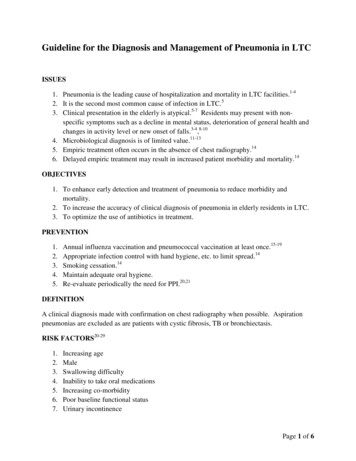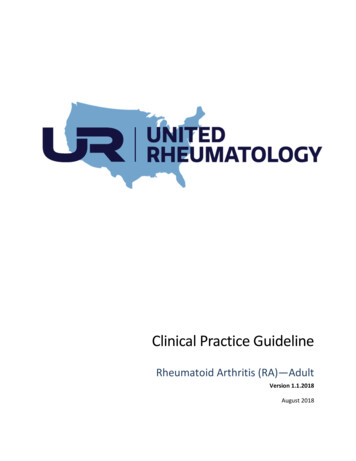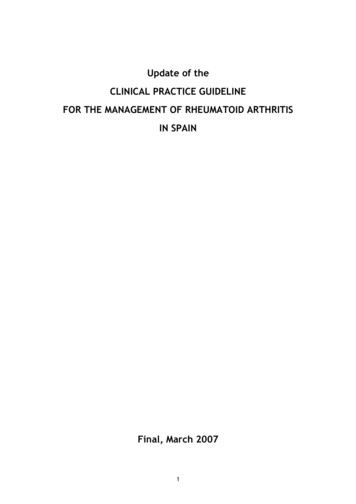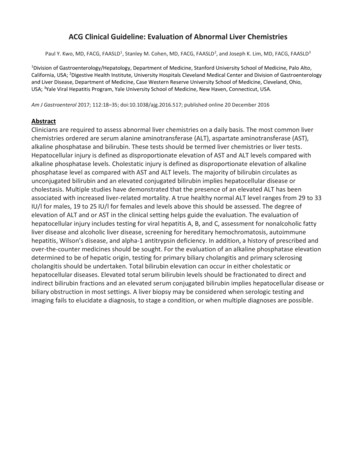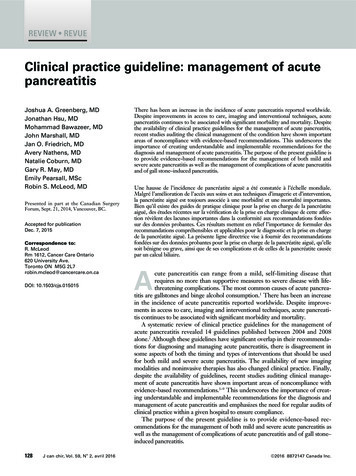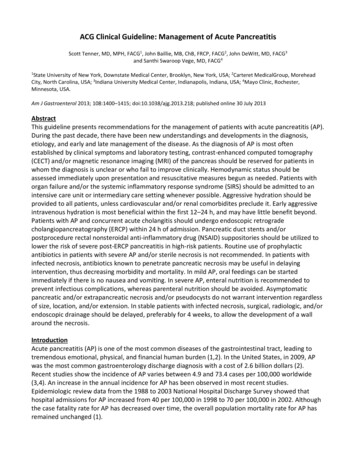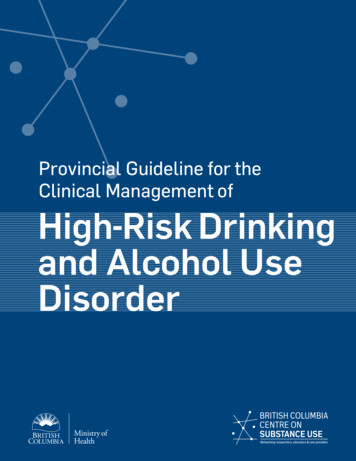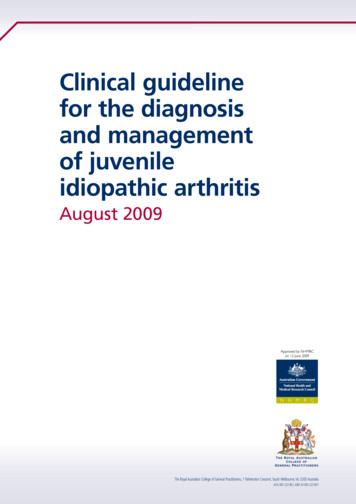
Transcription
Clinical guidelinefor the diagnosisand managementof juvenileidiopathic arthritisAugust 2009The Royal Australian College of General Practitioners, 1 Palmerston Crescent, South Melbourne, Vic 3205 AustraliaACN 000 223 807, ABN 34 000 223 807
Clinical guideline for the diagnosis and management of juvenile idiopathic arthritisThe National Health and Medical Research Council (NHMRC) is Australia’s leading funding body for health andmedical research. The NHMRC also provides the government, health professionals and the community with expertand independent advice on a range of issues that directly affect the health and wellbeing of all Australians.The NHMRC provided support to this project through the Guidelines Assessment Register (GAR) process. The GARconsultant on this project was Karen Grimmer-Somers.The guidelines were approved by the Chief Executive Officer of the NHMRC on 12 June 2009 under section 14Aof the National Health and Medical Research Council Act 1992. Approval for the guidelines by NHMRC is granted fora period not exceeding 5 years, at which date the approval expires. The NHMRC expects that all guidelines will bereviewed no less than once every 5 years.This publication was supported by funding from the Australian Government. The publication reflects the views ofthe authors and not necessarily reflects the views of the Australian Government.Published by:The Royal Australian College of General PractitionersCollege House1 Palmerston CrescentSouth Melbourne, Victoria 3205AustraliaTel 03 8699 0414Fax 03 8699 0400www.racgp.org.auISBN 978-0-86906-298-2Published August 2009 The Royal Australian College of General Practitioners. All rights reserved.
CONTENTSINTRODUCTION1Expiry date for the recommendations2Commonly used Aim of the guideline3Scope and target population4Focus of the guideline4Methods5The guideline6Limitations of the guideline7ALGORITHMS8Diagnosis and early management of JIA8Management of JIA9SUMMARY OF RECOMMENDATIONS10RECOMMENDATIONS FOR PRIMARY CARE OF JIA12Diagnosis of JIA12Early diagnosis and referral12History and clinical examination12Diagnostic investigations14Management of JIA15General principles15Multidisciplinary care and care planning15Patient education and psychosocial support16Pharmacological interventions17Simple analgesics (eg. paracetamol)17Weak opioids (eg. codeine)17Traditional non-steroidal anti-inflammatory drugs (NSAIDs)18Topical NSAIDs19Disease modifying anti-rheumatic drugs (DMARDs)19Complementary/alternative medicines20Non-pharmacological interventions20Nutritional therapies – calcium supplementation20Land based exercises21Aquatic exercise22Orthotics management (splints ready made and custom made)22Orthotics management (foot ve physical therapies23Disease monitoring and comorbidities24iClinical guideline for the diagnosis and management of juvenile idiopathic arthritis August 2009
Further Information25REFERENCES26Appendix A. Process Report28Appendix B. Resources35Appendix C. Membership and terms of reference of the RACGPJIA Working Group38iiClinical guideline for the diagnosis and management of juvenile idiopathic arthritis August 2009
INTRODUCTIONIn Australia, at least 5000 children are affected by juvenile idiopathic arthritis (JIA) at any one time.1,2Disease prevalence in Australia is between one and four cases per 1000 children.3 Juvenile idiopathicarthritis can have significant associated morbidity and mortality. Long term follow up studies have revealedJIA carries the potential for longer term inflammatory activity and complications, leaving a lasting impacton the patient’s function, growth and quality of life. Accurate and early diagnosis along with appropriatemanagement and referral are essential for maximising patient outcomes and quality of life.General practice plays an important role within the Australian health care system in prevention, earlydetection and chronic disease management (CDM). To manage chronic illness effectively requires wellcoordinated, patient centred care that is continuous, comprehensive, and consistent. General practitionersare well placed to provide this care and undertake this role in consultation with other medical specialistsas required.4–6 The role GPs play in CDM through multidisciplinary care coordination and long term careplanning is recognised within the national Medicare rebate framework. Children with arthritis are eligiblefor broader funding arrangements under CDM items for GP Management Plans and associated reviews.6As part of the Australian Federal Government’s Better Arthritis and Osteoporosis Care (BAOC) 2006–2007budget initiative,7 guidelines for the management of osteoarthritis, rheumatoid arthritis, and juvenile idiopathicarthritis have been developed to inform evidence based primary care of chronic disease in general practice.It is important that children presenting with JIA are diagnosed early; have initial management commencedby their GP; and are referred promptly to a paediatric rheumatologist. Because of the relatively lowprevalence of JIA in the general population, GPs often develop little experience with the diagnosis ormanagement of JIA. The Clinical guideline for the diagnosis and management of juvenile idiopathic arthritis hasbeen developed to fill that gap.The guideline presents recommendations to assist GPs managing patients with JIA. It focuses on shortterm care, long term care planning and management, and coordination of multidisciplinary care needs. Theguideline includes algorithms and resources to assist with the implementation of the recommendations.The guideline has been endorsed by the National Health and Medical Research Council (NHMRC).This project was supported by The Royal Australian College of General Practitioners (RACGP) and theAustralian Department of Health and Aging (DoHA). The following experts were involved in the developmentof the guideline as part of the RACGP Juvenile Idiopathic Arthritis Working Group:Dr Jane Munro (Chair), MBBS, MPH, FRACPDr Shane Brun, FFSEM(UK), FACRRM, FASMF, FARGP, MSpMed, DCH, GradDipRuralMed, GradDipEd,BAppSc, FRACGPDr Morton Rawlin, BMed, MMedSci, DipPracDerm, DipFP, DipMedHyp, DipBusAdmin, FACRRM, FRACGPPam Webster (consumer representative), MCH, BA, DipT, AUAProf Karen Grimmer-Somers (NHMRC advisor), PhD, MMedSc, BPhty, LMusA, CertHlthEcAmy Jasper, MBA, GDipHumServRes, BAppSci(AdvNsg)Dr Jiri Rada, PhD, FRSH, MSc, BPHE, BAEmily Haesler, BN, PGradDipAdvNsgThe following paediatric experts were involved as part of the Australian Paediatric RheumatologyExpert Group:Dr Roger Allen, MBBS, FRACPDr JD Akikusa, MBBS, FRACPDr Christina Boros, MBBS, PhD, FRACPDr Sue Piper, MBBS, FRACPDr Navid Adib, MBBS, PhD, FRACPDr Kevin Joseph Murray, MBBS, FRACPDr Jeff Chaitow, MMBCh, FRACPNOTE: All website references were current at the time of publication.1Clinical guideline for the diagnosis and management of juvenile idiopathic arthritis August 2009
Expiry date for the recommendationsThis guideline presents a comprehensive review of pharmacological and non-pharmacological managementof JIA within the Australian health care context, based on the best available evidence up to January 2007.Evidence published after this date has not been reviewed for the guideline.The guideline was approved by the CEO of the NHMRC on 12 June 2009, under section 14A of the NationalHealth and Medical Research Council Act 1992. Approval for the guidelines by the NHMRC is granted fora period not exceeding 5 years. It is expected that the guideline will be reviewed, and revised if necessary,no less than once every 5 years. Review should be more frequent in areas where clinical practice orresearch is known to be changing rapidly. Readers should check with the RACGP for any reviews or updatesof the guideline.Commonly used abbreviationsACR 30/50/70American College of Rheumatology Paediatric 30/50/70 criteriaAEadverse eventANAantinuclear antigenBMCbone mineral contentBMDbone mineral densityCDMchronic disease managementCHAQChildhood Health Assessment QuestionnaireCIconfidence intervalCOX-2cyclo-oxygenase-2 selective inhibitorsCRPC-reactive proteinDMARDsdisease modifying antirheumatic drugsEPCenhanced primary careESeffect size: 0.2 small effect, 0.5 moderate effect, 0.8 large effectESRerythrocyte sedimentation rateFBCfull blood countGITgastrointestinalGPgeneral practitionerHRQOLHealth related quality of life (usually measured on a self reported 10 cm VAS)HLAhuman leukocyte antigenJIAjuvenile idiopathic arthritisLFTsliver function testsNSnot statistically significantNSAIDsnon-steroidal anti-inflammatory drugsNHMRCNational Health and Medical Research CouncilRACGP[The] Royal Australian College of General PractitionersRCTrandomised controlled trialRhFrheumatoid factorROMrange of movement/motionSRsystematic review (also used in this report to describe meta-analysis)TENStranscutaneous electrical nerve stimulationVASvisual analogue scaleWMDweighted mean difference2Clinical guideline for the diagnosis and management of juvenile idiopathic arthritis August 2009
BackgroundJuvenile idiopathic arthritis is a chronic, autoimmune, inflammatory joint disease. It is the most commonrheumatic disease in children and adolescents. It is defined as ‘persistent arthritis of unknown aetiologythat begins before the age of 16 years and persists for at least 6 weeks’. It is diagnosed after excludingother causes.8The cause of JIA is unknown. It is suspected that environmental factors such as viral infections may triggerthe condition in genetically susceptible children.9 However, it is unusual for more than one child in a familyto have arthritis.The aim of treatment is the induction of remission and control of the disease to minimise pain and functionloss, and maximise quality of life. There is currently no cure for JIA. Treatment has altered as a result ofrecent research into the best practice approach to managing children. This guideline reflects the currentevidence based approach to managing children with JIA.ClassificationThere are seven subtypes of JIA:81. Oligoarticular – affects four or less joints. This is the most common subtype2. Polyarticular (RhF negative) – when five or more joints are affected. Rheumatoid factor (RhF)antibody is not found on blood testing3. Polyarticular (RhF positive) – when five or more joints are affected and RhF is found on bloodtesting. This subtype may behave similarly to rheumatoid arthritis in adults4. Systemic – a chronic arthritis associated with systemic features, including high spiking fever, transientepisodic erythematous rash, lymphadenopathy and hepatosplenomegaly (systemic features often precedethe arthritis)5. Enthesitis related – (previously known as juvenile spondyloarthropathy). This is a chronic arthritisassociated with enthesitis (inflammation at insertion of tendons, ligaments or fascia to bone), or withlower axial skeletal involvement. HLA B27 is present or there is a family history of a first degree relativewith a HLA B27 related disease. A significant proportion of patients will develop sacroiliitis as adults,but back and sacroiliac joint involvement is uncommon during childhood6. Psoriatic – chronic arthritis, usually with asymmetrical involvement of small and large joints, and eitherthe development of psoriasis or other evidence of a psoriatic diathesis (two of the following: familyhistory in a first degree relative, nail pits or onycholysis, or dactylitis).7. Undifferentiated arthritis.PrognosisFor many years it was believed that most children eventually outgrow JIA. Now it is known that half of childrenwith JIA will still have active arthritis 10 years after diagnosis unless treated appropriately. In moderate tosevere cases, JIA can produce serious joint and tissue damage and cause problems with bone development andgrowth.10 In some cases, JIA symptoms are mild and do not cause progressive joint disease and deformities.In the past, JIA has often been seen as a benign condition, which it is not. Children presenting withJIA may be diagnosed inappropriately as having non-specific joint paints, ‘growing pains’ or recurrentmusculoskeletal ‘sprains’. As a result appropriate referral and treatment is delayed.The outcomes for children with JIA are improved if managed by a multidisciplinary team with the inputof a paediatric rheumatologist.11,12Aim of the guidelineThis guideline seeks to provide recommendations for the early diagnosis and multidisciplinary managementof JIA in the primary care setting. The recommendations focus on the primary care practitioner’s role in: early identification of JIA early referral to a paediatric rheumatologist prevention of complications associated with JIA alleviation/minimisation of pain optimal management of acute exacerbations of JIA prevention and minimisation of joint damage maximisation of functionClinical guideline for the diagnosis and management of juvenile idiopathic arthritis August 20093
optimisation of normal growth and development improved quality of life.Scope and target populationThis guideline is intended for use in the primary health care setting by health care professionals workingwithin a multidisciplinary team, including GPs and the following allied health professionals: physiotherapists;occupational therapists; sports medicine personnel; podiatrists; dieticians; psychologists; pharmacists; nursesand community health workers.It is intended for patients under the age of 16 years presenting with arthritic symptoms, as well as thosediagnosed as having JIA. It does not cover patients over the age of 16 years, treatment of extra-articulardisease, or surgical interventions.This guideline has been developed for use in primary care settings in metropolitan, regional, rural andremote areas of Australia.Focus of the guidelineThe guideline focus is on JIA. It does not cover the management of other forms of arthritis, or com
Clinical guideline for the diagnosis and management of juvenile idiopathic arthritis August 2009 BaCkgROUND Juvenile idiopathic arthritis is a chronic, autoimmune, inflammatory joint disease. It is the most common rheumatic disease in children and adolescents. It is defined as ‘persistent arthritis of unknown aetiologyFile Size: 879KBPage Count: 43
